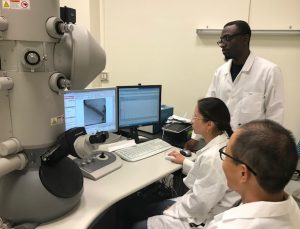Study Assesses a New Class of Safer, More Effective Dispersants
– AUGUST 21, 2018
Researchers analyzed an enhanced formulation of a gel-like surfactant encased in a compact buoyant pod for oil spill remediation. Adding Tween 80 to the existing gel-like formulation of dioctyl sulfosuccinate or DOSS and phospholipid (a lecithin component) increased emulsion stability and generated smaller oil droplets that remained stable for extended periods compared to traditional liquid dispersants. Though lower dispersant-to-oil ratios yielded more than two orders of magnitude reduction in interfacial tension, the synergistic interactions of the surfactant components played the major role in stabilizing the oil-water interface. The increased structural integrity of the gel-like surfactant system imparted improved buoyancy characteristics, leading to potential applications as a floating oil spill dispersant. The researchers published their findings in the Journal of Colloid and Interface Science: Microstructural characteristics of surfactant assembly into a gel-like mesophase for application as an oil spill dispersant.
Chemical dispersants help break up oil slicks, which can reduce shoreline oiling and enhance biodegradation. However, the liquid formulation traditionally applied often suffers from spray drift or is washed away by currents, especially when applied to heavy or weathered oils. Study author Vijay John explained more about the existing dispersant system, “The main components of an oil spill dispersant are surfactants, which are essentially soaps. The most widely used dispersant is Corexit 9500 EC, which was used in the Deepwater Horizon incident. Some of the surfactants in Corexit dissolve in water and some do not but, instead, dissolve in an organic solvent. To make a homogeneous mixture of all the surfactants, a combination of solvents is used, typically propylene glycol and petroleum distillates, [which can generate volatile compounds].”
Previous research revealed that two food grade materials, a lecithin component L-α-phosphatidylcholine (PC) and Tween 80, dissolved in ethanol is just as effective at stabilizing oil-in-water emulsions as Corexit 9500. The addition of water to a solution of PC and DOSS creates a gel-like mesophase that can incorporate high water content. In this study, the research team incorporated Tween 80 into the gel-like mesophase and conducted experiments to demonstrate how the new formulation improved the stabilization of crude oil-in-saline water emulsions.
To understand the gel’s microstructure, the team used small angle neutron scattering (SANS) done at the Spallation Neutron Source (SNS) located at the Oak Ridge National Laboratory (ORNL), a Department of Energy national laboratory. “The results clearly showed us that the microstructure was a set of stacked sheets or lamella,” said John. “We also did cryogenic scanning electron microscopy which further indicated that the sheets were not flat but rather rolled up, similar to a rolled-up carpet, but on the nanometer scale.” This shift in structure increased the gel microstructure’s length, which improved its buoyancy.
“The gel formulation that we have designed largely replaces DOSS (a synthetic surfactant component that degrades relatively slowly) with soybean lecithin (a phospholipid that is used as a food grade emulsifier), which is essentially benign since it is a component of cell membranes,” said John. “Delivery of the gel dispersant as pods avoids the use of propylene glycol and the generation of volatile solvents in the atmosphere through aerial or boat-based spraying and is, therefore, far safer on first responders and oil spill treatment personnel.”
John explained the potential of their results, “Translation of our findings to practice would provide an alternative option to the treatment of surface spills and small spills where the dispersant can be accurately delivered without the release of large amounts of solvents. In the case of weathered oil, it is possible to make the gel formulation adherent to the oil mousse to allow the oil to be dissipated and dispersed into droplets. In contrast, liquid dispersants often wash over the side of weathered oil and are lost by dissolution into the water column. The fact that there is an alternative option to consider in dispersant applications besides the spraying of liquid dispersants, has major implications to the treatment of oil spill.”
Data are publicly available through the Gulf of Mexico Research Initiative Information & Data Cooperative (GRIIDC) at doi:10.7266/N7KP80N4.
The study’s authors are Olasehinde Owoseni, Yueheng Zhang, Marzhana Omarova, Xin Li, Jyotsana Lal, Gary L. McPherson, Srinivasa R. Raghavan, Arijit Bose, and Vijay T. John.
************
This research was made possible in part by a grant from the Gulf of Mexico Research Initiative (GoMRI) to Louisiana State University, Louisiana Tech University, Tulane University, the University of Maryland, the University of Minnesota, and the University of Rhode Island for their projects The Design of Synergistic Dispersant and Herding Systems using Tubular Clay Structures and Gel Phase Materials and Molecular Engineering of Food-Grade Dispersants as Highly Efficient and Safe Materials for the Treatment of Oil Spills. Other funding sources include the U.S. Department of Energy (EPSCOR Grant No. DE-SC0012432) and the Louisiana Board of Regents.
The Gulf of Mexico Research Initiative (GoMRI) is a 10-year independent research program established to study the effect, and the potential associated impact, of hydrocarbon releases on the environment and public health, as well as to develop improved spill mitigation, oil detection, characterization and remediation technologies. An independent and academic 20-member Research Board makes the funding and research direction decisions to ensure the intellectual quality, effectiveness and academic independence of the GoMRI research. All research data, findings and publications will be made publicly available. The program was established through a $500 million financial commitment from BP. For more information, visit https://gulfresearchinitiative.org/.
© Copyright 2010-2018 Gulf of Mexico Research Initiative (GoMRI) – All Rights Reserved. Redistribution is encouraged with acknowledgement to the Gulf of Mexico Research Initiative (GoMRI). Please credit images and/or videos as done in each article. Questions? Contact web-content editor Nilde “Maggie” Dannreuther, Northern Gulf Institute, Mississippi State University (maggied@ngi.msstate.edu).






